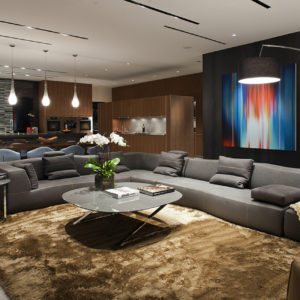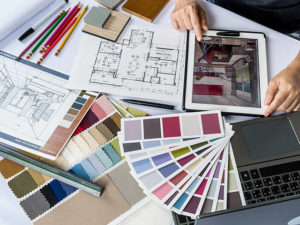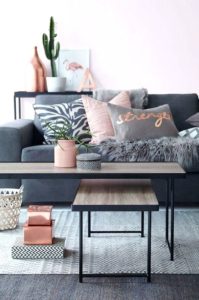
Login
X
- Home
- About Us
- Courses
- Graduation
- Diploma Certificate
- Professional Diploma
- Special sessions / Aptitude boost up
- News & Events
- Student zone
- Placement
- Gallery
- FAQ
- Contact Us

You must be wondering how to become an interior designer? Suppose you plan to make your career in interior designing and need clarification about how it matches you and will offer good job options in the future. Here comes the right guide to help to know about an interior designing program and its career prospects.
Interior designing is the planning, designing, and implementation of architectural interiors. The interior space of a building must be designed by a professional interior designer who comprehends interior architecture. If you have the drive and imagination to design commercial and residential spaces, interior design is a great career choice. It offers a chance for a global career and the freedom to practice independently.
The best interior design schools in India provide thorough undergraduate and graduate interior design programs to those interested. Having the appropriate credentials in interior design could help you start a successful career. To obtain the necessary education, training, and abilities for the position, you can pursue a B.Sc. in Interior Designing as an undergraduate degree and then an M.Sc. in Design Space as a postgraduate degree. You can also look at some colleges’ interior design diploma programs. Even if you start your own interior design business, having legitimate credentials from one of India’s top interior design universities is always preferable. Your clients would feel more comfortable hiring you if you had these credentials when designing or renovating their space.
Numerous opportunities are available to candidates who have successfully attained the required qualifications in interior design. They are employable as lighting designers, aesthetic merchandisers, production designers, art directors, exhibition designers, and interior and spatial designers. Additionally, they can start their own interior design business and work with various clients. It is important for interior designers to stay up-to-date on the latest trends since the industry is highly competitive.
Woohoo!! Now you got an idea for how to become an interior designer? So, don’t wait!! Grab your seats from the top interior design college.

Interior designing is a sort-after career choice that is exclusively for the candidate who wants to have creative liberty. It combines mathematics and arts to create visual harmony and peace. Therefore, some colleges fall under the top 10 interior designing colleges in Kerala and some don’t.
The evaluation is based on
Higher the number of applications and lower the number of seats. hence, Some colleges conduct entrance tests where thousands of students compete for a limited number of seats.
Renowned and well-known faculty with experience and qualifications beyond just teaching. Besides that Some faculty and staff members are well known of top colleges same goes for the alumni. If the students who passed out to become major sharks of the industry, dominating the field. It gives off a well-round reputation for the college or department.
One of the major contributors to being on the list of top 10 colleges in Kerala is affiliation and certification. furthermore, The value of the University the college is associated with is used to determining whether the college goes under the list. Which will ultimately determine the value of your certificate of education.
How equipped the college is in terms of facilitating the course/degree offers makes a huge difference in the ranking of the college. For Interior designing other than just classroom learning to develop the students in creative ways well-equipped studio, laboratory with software such as 3DS Max, Ravit, Sketch-up, etc are necessary. Other extra-curricular activities like expert sessions, site visits, and industrial visits could determine the quality of education provided.
Vismayam College of arts and media falls under one of the top 10 colleges. More than a decade of devotion to perfect the art of teaching. Dedicated faculty and well-equipped studio and facilities for interior designing students. graduates get placement in various firms aided by the college’s placement team.

If interior design has always fascinated you, then you should definitely explore career scope in interior design. The aim is
to become a successful interior designer who is skilled in all aspects of designing, be it space planning, furniture
designing, lighting, landscaping, applying fabric finishes or any other design branch. So the big question is-what are the
areas that have to be extensively understood to start working as an interior designer? Read on.
It remains an effective tool to convey ideas. Freehand sketches, proportional drawings, measured
drawings, projections; rendered illustrations- the category is specifically aimed at making you perfect in
conveying your designs to both laymen as well as professionals. Be it furniture, furnishings or views, graphics
help you in effective visual communication.
Design and architecture are constantly evolving. Naturally, one should be well informed about
existing and useful materials when it comes to construction and design of buildings, furniture and other
elements. A thorough knowledge of materials includes information regarding suitable as well as avoidable
materials according to the local climate of an area. Apart from improving efficient designing, the knowledge of
materials is very important in economizing the total designing process and making the project cost efficient.
Design is everywhere, literally. With increasing emphasis on environment, a designer these days
is expected to apply his/her skills not only to the house, but to its surroundings as well. Shrinking spaces have
led to the popularity of interior landscapes as well, such as courtyards and water bodies.
4. FABRICS. Interior fabrics such as carpets, curtains, upholsteries, bed spreads, table linen, kitchen linen to name
a few, add that hint of comfort and supple finish to a well defined interior. One should be aware of the vast
collection of soft furnishings available in the market these days, their uses, advantages and disadvantagesbefore they are applied to an interior.
What makes an interior attractive? The answer to this question forms the content to be learned in
aesthetics. Apart from effective arrangement of individual interior pieces, it is equally important to understand
the design secrets that add the Midas touch. A successful interior is the result of strategic application of design
principles and elements.
Each member of a family has his/her own choice when it comes to design and color. A clever designer is
successful in making the best of all selections and creating interiors that please the whole family. What comes
handy in that situation? A thorough understanding of colors. The right type of color in the right amount results
in the right outcome.
Some designers have keen interest in taking residential projects, others focus on
commercial sectors. When an interior design student is ready to begin his/her practice, they tend to have a fair
idea about their preferred areas. A multitude of specialties exist, such as kitchen design, product design,
furniture design, color consultancy, lighting and so on.
A building needs some essential services such as plumbing, fire and safety, adequate
heating and ventilation and electricity and interior designers make sure that all required services are
incorporated in a structure at the planning stage itself.
It is not just about Vastu or Feng Shui. Space planning requires in-depth knowledge regarding
building laws, bye- laws and related legal insights. It not only saves time in the planning stage itself, but it also
eases out many steps during construction period for both the client and the designer.
Depending on what course you select, you might learn some more or may superficially cover a particular topic during
course duration. The happy news is, learning does not have an expiry date! Armed with a strong theoretical and practical
base, you can make it big with time, perseverance and experience in the field of interior designing

Beautiful spaces need careful planning and fruitful teamwork. Be it any type of space, designers definitely add value to the overall end use and looks of it. So, getting them on board is absolutely sensible. But, should you approach an interior design company or should you seek a freelancer?
While there is no doubt that these services may add to your expenses, however, they cut down both short term and long term liabilities. Here, the real work is to sort out the exact interior design company that will suit your project. Or, if it makes sense, a freelancer. But how do you decide on it?
While a freelancer may be more open to financial negotiation, a design firm may render a more professional service. Now, if you look at the current design industry, there is plenty of work for both freelancers and firms. Both are busy with their respective shares of projects.
For a better understanding, let us talk about an interior design company first. Well, a company has employees and employees need salaries. Add to that, the overheads of running the firm. Yes, such firms need sizable projects to sustain their livelihood. Having a fleet of trained workers and teams cuts down the working time considerably. Which proves more beneficial to the client that the firm charges. You see, time is money.
Then, the fact that they establish a work flow, reduces distractions and confusions, which again fastens the whole design process.
On the other hand, a freelancer is mostly a beginner or someone who works more for the sake of passion. If we talk about a beginner, this designer probably has an internship experience and now wants to self- evaluate. That evaluation may be in terms of creativity, supervision, time management and material management. Generally, internships prepare these designers with the typical work flow a project may demand. Hence, many skilled designers indulge in this practice.
With freelancers, you have a bigger bracket of bargaining and more flexible method of working. Often, the client and the freelancer spend a lot of professional time together. This way, a lot of discussion goes into the details of the project. Of course, freelancers also have their own teams of workers. Naturally, the interactions are more one-to-one than those with a typical interior design company.
Working with an established firm gives you many perks.
With freelancers, you get to experience different advantages.
Be it a house or an office, ultimately, useful design is the product of hard work and talent.
It is this very reason that you see many freelancers in design field. With their talent, perseverance and passion, they keep completing projects to their clients’ satisfaction. And most of the times, they source their works from mouth- to- mouth publicity.
On the other hand, when you entrust your project to an interior design company, the whole procedure becomes a cakewalk. Since they are already familiar with foolproof methods and techniques, You can literally throw away your worries and be a spectator to the progress of work.
There is no hard and fast rule regarding which project for whom. All types of designers can indulge in all types of project. Here, the only things that matter are their creativity and talent in making your design concept come to life.

Your home speaks volumes about the person you are. When you decorate your house, you actually make your design statement. Moreover, when you design your house cleverly, your daily routines improves for the better. Now if you think you don’t have the skills, don’t worry. Like the saying goes, stay calm and hire an Interior designer!

Yes, hiring means paying a service fee. But is it worth the effort? This blog lists down 10 benefits of hiring an Interior Designer.
That precious dream house of yours will definitely improve if a designer plans it. That is because they specialize in creating such spaces. So, you may forget a tiny but important detail while making your plan but they won’t,for sure.

Designers know how to work within a budget. Well, as a first experience, it may prove to be quite overwhelming- designing your house from scratch. But a designer can save your time and money since that’s what they learn and practice. Co-operate with your Interior Designer and see how it works like magic. Also, another misconception is that designers work on big projects only. You should know that a successful designer gets the job done in ANY budget- big or small.
Worried about from where to source that beautiful carpet you spotted elsewhere? Or are you getting confused by the minute about deciding on a flooring option? Here comes a designer to your rescue. A seasoned designer knows which design and material will suit best. He/she has a working relationship with the local markets,suppliers and dealers. In fact, they often crack super saver deals for their clients.

When you decide to renovate or design your interiors, you will either be browsing internet or going through design magazines for “inspiration”. Now, wouldn’t it be way better if your house showcases original creative designs? So, let your Interior designer do that bit.
The living rooms, bedrooms and other spaces in your homes are the evolved answers to man’s spatial needs. Hence, it is always better to customize spaces depending on the families/people who use it. And this is something in which interior designers are experts at. Thus, a cleverly designed interior makes full use of available space to the best functions of the family members.

An interior designer may surprise you with the amount of general awareness they have regarding the latest trending style and design elements. Of course, that’s their job. So if you happen to prefer only the latest for your interiors, then a designer is the right person for the best possible looks and feel.
Work on a project with an interior designer to know what you were missing in your own home sweet home! There may be numerous details which you were never aware of before. In fact, some people come to know about the different expectations their own family members have, when they start discussing it with their designers.
Not hiring a designer while designing your house is actually becoming penny-wise and pound-foolish! For a work that can be done in three straight months at the most with the help of a designer, you tend to add months and days to avoid a nominal fee. And so, when you tally, you happen to incur far more losses in terms of time and money when compared to getting the job done by a designer.
Ultimately, it is your personal choice whether or not to hire a designer. We hope the above points help you in taking a sound decision when you contemplate redoing your own abode!

One of our previous blogs gave pointers on the different subjects to be studied under interior design . So you get all excited and get admission into the best interior design college in calicut. Classes begin and now you have industry experts and design professionals bombarding you with new terms and alien concepts. You struggle to absorb all of it and frankly that’s natural. This leads you to a learning crisis in interior design. You start asking yourself, is this what I signed for?
Troubled much? Don’t worry! In this section you will find some useful tips on learning and making use of all the knowledge provided to develop into a successful interior designer.
Observe each step, each line carefully as your instructor draws anything on the white board in front of you. The final illustration matters, yes. But you end up learning a thing or two about presentation sketching apart from the illustration itself.
You bought that instrument kit when academic sessions began, in the heat of the moment. Overtime with routine use, you developed a bit of drawing skills and then one fine morning you decide to skip the set, right? Wrong. You have just started. The nuisance of wasted moments over handling the instruments in the beginning of your classes will gradually become a reflexive method every time you want to start drafting/drawing.
Remember the addition, multiplication, subtraction and division sums that you solved in your primary classes? Yep, that’s pretty much what is required by you to master. Proportion and scaling is frequently practiced. It helps a great deal when you can mentally calculate on the spot whenever required. Moreover, a fair idea of feet, meter and centimeter is always a huge advantage.
The habit of surfing through design and architecture magazines is definitely one to keep. Don’t restrict yourself to magazines only; don’t spare any source that enlightens you in this field. It is very important to be aware of the latest trends and developments. You will be surprised with your own academic development once you become proactive.
Seek a new learning daily. Go through what was taught in the class daily, don’t mug up. Just note whether there is anything that you didn’t understand. Make an effort to clarify your doubts the very next day. Once you set a routine, things will look better.
Never settle for the current piece of information. Interior design is a highly dynamic field. Keep researching in the existing avenues. Keep searching for new elements. Market surveys matter a lot in interior design and so does Rate analysis. Not only do they make you aware of current market rates and scenario, they also help you with your initial stages of career, be it as an employee or as a freelancer.
Try your best to not miss any class. It is all the more crucial in practical sessions, site visits and presentations. These are not being conducted just to kill your time. The skills gained from these classes reflect in your works and the knowledge gained first-hand is irreplaceable. Learning by doing is a big, big part of Interior design.
Searching for a premium interior design college? Click on college website to know more.
Phone: 0495 272 2242